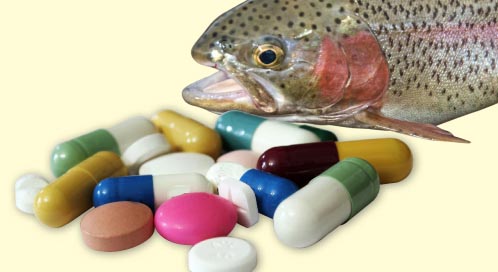This is Your Ecosystem on Drugs

He’s no psychiatrist, but Tomas Brodin does dispense anti-anxiety medication—to fish—in the same concentration as can be found in waterways around the world.
A researcher at Umea University in Sweden, he discovered that only trace amounts of oxazepam—a commonly prescribed anti-anxiety medication—made European perch bolder, spending less time under cover and more time feeding out in the open. The behavioral changes Brodin observed in the lab could have major implications for fish in the wild, ultimately affecting the trajectory of their evolution.
And oxazepam isn’t the only drug in the sea.
The waterways of the United States and other industrialized nations are awash with the miracles of modern living: Dissolved quantities of pharmaceuticals, including prescription, over-the-counter, veterinary and illegal drugs, along with detergents, cosmetics, fragrances and sunscreens can be found anywhere human activity flows into rivers, lakes or coastal waters. Designed to react biologically and to resist degradation, these “emerging contaminants” are of growing concern to ecologists.
While ubiquitous, these pollutants usually exist in very low concentrations. Waterways downstream from sewage outflow and agricultural runoff see the highest levels, but in most places these contaminants are recorded in parts per trillion—a unit equivalent to one drop in 20 Olympic swimming pools. These exceptionally diluted concentrations have no documented effect on humans, but aquatic animals spend their entire lives swimming in these contaminants. Chronic exposure can damage cells, resulting in cancer, mutation and loss of fertility in fish, invertebrates and microscopic life.
“There are hundreds of compounds we use every day that enter the waterways,” says Melody Bernot, a biologist at Ball State University in Indiana. Soaps, shampoos, cosmetics and perfumes wash down our drains. Portions of the medications we take pass through our bodies intact and end up in sewage. You shouldn’t flush most unused pills, but what isn’t absorbed in the body, flows down the drainpipe anyway.
Before entering ecosystems, most emerging contaminants must pass through sewage treatment systems. These systems vary substantially in efficiency from urban treatment plants to rural septic tanks, but very few are specifically designed to eliminate these new pollutants.
“Do we have the technology to remove most contaminants from water? Yes,” says Gregory Korshin, a researcher at the University of Washington. However, every technique has its limitations. Some bottled water suppliers use reverse osmosis membranes, which filter virtually all pollutants from the final product, but the byproduct is highly concentrated wastewater. Exposure to ultraviolet light, ozone and free radicals, alone or in combination, can degrade all but the most resilient contaminants, but these techniques are expensive to implement on a large scale. And water-management utilities don’t have any incentive to try.
Emerging contaminants are currently unregulated. The Environmental Protection Agency is interested in researching the problem, but too many unknowns currently exist to draw up binding regulations. Thousands of consumer chemicals are on the market with more being developed every day. The way they interact in natural ecosystems is complex. No one treatment can degrade every compound, and money for environmental research is often hard to come by. But one thing’s for certain: The concentrations and ramifications of emerging contaminants in our waterways are only likely to increase.
It’s enough to make you reach for some anti-anxiety pills.
Get Up, Stand Up
Don't flush unused medication down the toilet. Instead mix it with kitty litter or coffee grounds and discard or look for drug take-back programs in your area.
Avoid anti-bacterial soaps. They help breed the superbug, and the portion that washes down your drain can wreak havoc on aquatic life.
Avoid zinc pyrithione in dandruff shampoo, which can be toxic to many organisms, and use eco-friendly cleaners. They degrade and don't disrupt cellular activity.
Don't do laundry and run dishwashers on rainy days when treatment plants can get overloaded with household wastewater and storm waters and open sewers straight to waterways without treatment or filters.
—Matthew Hardcastle
Only select articles from Defenders are available online. To receive 4 issues annually of the full award-winning magazine, become a member of Defenders of Wildlife!
